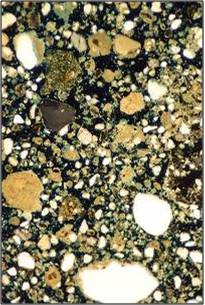
RoadBond EN-1 Abilene Summary Report
Abilene Roadbond EN-1 Summary Report
Laboratory tests performed on Abilene FM 57 samples treated with Roadbond EN-I involved the Tube Suction Test, Compressive Strength Test at three different confining pressures, construction of the envelope offailure for each sample, and classification of the material. EN-I was mixed with water at a ratio of 1:250. Six samples were made for testing: 1 with no EN-I, 2 with 1% EN-I, 2 with 3% EN-I, and 1 with 5% EN-I.
Samples were mixed in accordance with the mixing instructions provided to ITI at the previously determined OMC of 12.2%. After compaction, the samples were allowed to cure 7 days in the wet room. Following the 7-day cure, the samples were placed in a 104
F room for 6 days to dry in preparation for the Tube Suction Test.
Tube Suction Test Results
At the end of the 10 day Tube Suction Test, no samples had final surface dielectric values greater than 10 (which is the proposed maximum surface dielectric for a material to perform exceptionally in the presence of water). The beginning and ending surface
dielectric values for each sample are below.
Table 1: Initial and Final Dielectric Values for Abilene Tube
Suction Samples
| Sample | Initial Dielectric | Final Dielectric |
| 0% EN-1 | 9.0 | 9.6 |
| 1% EN-1 | 7.8 | 9.4 |
| 1% EN-1 | 8.5 | 9.7 |
| 3% EN-1 | 8.1 | 9.3 |
| 3% EN-1 | 7.6 | 9.3 |
| 5% EN-1 | 8.5 | 9.5 |
Compressive Strength Tests
Compressive strength tests were performed at the end of the Tube Suction Test on one sample of each Roadbond EN-I content. The samples were tested beginning at 1 psi confining pressure, then at 5 psi, and lastly at 10 psi. Because of a lack of material, enough samples were not available to test a new sample at each confining pressure. Due to this constraint, the failure point for each sample was estimated to be where the ones digit on the load had to change four times before the tens digit would change.
In compressive testing, all treated samples had a higher maximum strength value than the untreated sample. The maximum strength values are in Table 2, along with the maximum and minimum gains from treating the samples with EN-I
Table 2: Compressive Strength of Abilene after Tube Suction Tests
| Confining Pressure | 0% EN-1 psi | 1% EN-1 psi | 3% EN-1 psi | 5% EN-1 psi | Max Strength Gain | Min Strength Gain |
| 1 psi | 41.9 | 65.8 | 63.7 | 76.0 | 81% | 52% |
| 5 psi | 63.6 | 85.4 | 85.6 | 101.0 | 59% | 34% |
| 10 psi | 88.9 | 109.0 | 114.8 | 125.6 | 41% | 23% |
Classification Of Material
After strength testing and construction of Mohr's diagrams, the failure envelopes for the samples were transposed onto the Chart for Classification of Subgrade and Flexible Base Material (attached). From testing, the classification of the materials is as follows:
• 0% EN-I: Class 3.0
• 1% EN-I: Class 2.4
• 3% EN-I: Class 2.3
• 5% EN-I: Class 2.1
Conclusion
In laboratory testing, all of the Abilene FM 57 samples prepared passed the Tube Suction Test with final dielectric values less than 10. Samples with 0, 1,3, and 5% EN-I underwent this test. Following the Tube Suction Test, the samples were strength tested. It was found that the Roadbond EN-I treated samples were significantly stronger than the untreated. At the manufacturers' recommended 3% level of treatment, the treated sample had strength gains of 52%, 34%, and 23% over the untreated sample (at 1, 5, and 10 psi confining pressure, respectively). The strength gains from treatment were sufficient to move the Abilene material from a Class 3.0 for the untreated sample to Class 2.1 for the sample treated with 5% EN-I mixture. The sample treated with 3% EN-I mixture was determined to have a class of 2.3. Currently all the samples are sealed and in a wet room, as more studies are planned to investigate what kind of chemical and/or physical changes took place to cause the observed strength gains apparently from EN-I treatment.